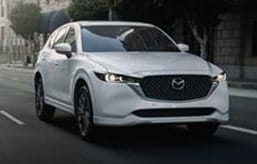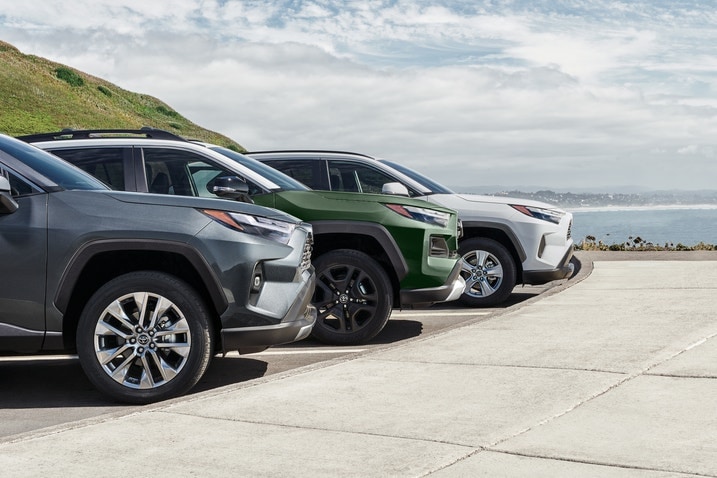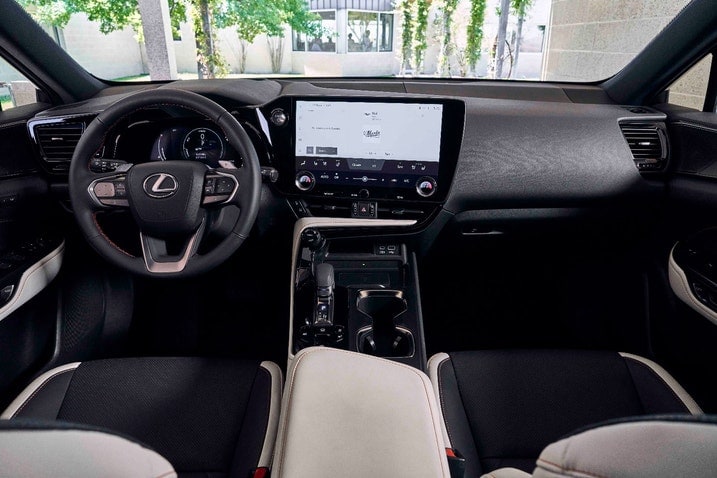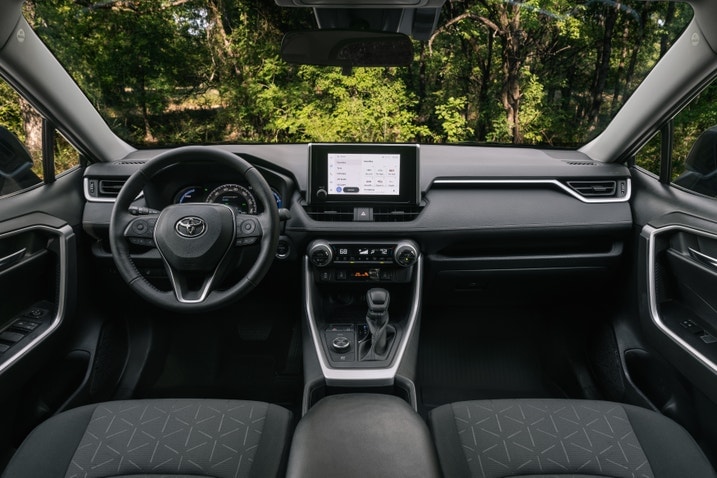- Toyota’s RAV4 is an extremely popular utility available with a hybrid powertrain.
- The Lexus NX, which shares a platform with the RAV4, ups the standard equipment but includes shorter warranty coverage.
- Which of these hybrid compact crossovers is right for you?
2025 Toyota RAV4 Hybrid vs. Lexus NX 350h Hybrid: How Do These Related Compact SUVs Stack Up?
The RAV4 and NX offer similar hybrid powertrains but different interior trappings and different value propositions
You might not notice from a glance, but the Toyota RAV4 and the Lexus NX share a lot in common underneath. These two compact crossovers represent the Japanese automaker’s mainstream (Toyota) and luxury (Lexus) entries in this crowded segment. If you’re considering one, the other is also worth a look.
For 2025, the Toyota and the Lexus are both available with a gas engine or a plug-in-hybrid powertrain in addition to a traditional hybrid setup. Come 2026, however, the RAV4 switches to a new generation and will only offer a hybrid (with a new base front-wheel-drive version) and a plug-in hybrid variant. The new RAV4 makes big changes to the crossover's formula, but since Toyota hasn't released full specs for its new SUV yet, we're using the 2025 model in this comparison.
We’ve focused on the hybrid version of both models for this comparison. Read on to see how power, fuel economy, packaging, and features differ between the Toyota and the Lexus.
Toyota RAV4 Hybrid vs Lexus NX 350h Hybrid: Powertrains compared
Toyota RAV4 Hybrid | Lexus NX 350h Hybrid | |
|---|---|---|
| Engine | 2.5-liter inline four-cylinder, two electric motors | 2.5-liter inline four-cylinder, two electric motors |
| Horsepower | 219 hp | 240 hp |
| Torque | N/A | N/A |
| Transmission | continuously variable automatic | continuously variable automatic |
| Drive type | AWD | AWD |
| Fuel economy | 38-41 city, 35-38 highway, 37-39 combined mpg | 41 city, 37 highway, 39 combined mpg |
Engines and fuel economy
Both the RAV4 and the NX 350h use a version of Toyota’s well-known hybrid system, which is based around a 2.5-liter four-cylinder engine. Output numbers differ, however, with the Toyota generating a system total of 219 horsepower and the Lexus outdoing it by 21 hp, for a total of 240 horsepower. In both cases, there’s an additional traction motor at the rear axle that enables all-wheel drive when needed.
Even with the power difference, drivers aren’t likely to notice much of a difference between these two in terms of acceleration performance. In Edmunds' testing, the RAV4 Hybrid went from 0 to 60 mph in 7.8 seconds, while Lexus quotes a 7.2-second run for the NX 350h.
It’s a similar story at the gas pump. Efficiency numbers are strong and pretty closely aligned — 39 mpg combined for the Lexus and most versions of the Toyota. Only the RAV4 Woodland Edition strays from the Lexus in this category, as its all-terrain tires and off-road suspension cause a slight hit to mileage ratings.
Interior
Passenger-space measurements are also pretty evenly matched between the Toyota and the Lexus, although the RAV4 has a slight edge. The NX 350h's rakish roofline eats into headroom a bit up front and a little more in the rear, and its legroom total is below that of the RAV4. So although both models seat five, the folks in the Toyota will have a bit more room to stretch out.
The Toyota’s boxier, upright styling also pays dividends in cargo capacity. With the rear seats in place, the RAV4 can swallow nearly an additional 15 cubes. Fold those seats, and the volume expands to a healthy 69.8 cubic feet, almost 23 cubes ahead of the Lexus.
Both vehicles have relatively quiet interiors. The Toyota lets through coarse engine sounds when you step on the accelerator pedal, while the Lexus, which likely has more sound-deadening material, transmits more hum from the tires than we’d like. The RAV4 offers a variety of cloth upholstery options, while the Lexus comes with vinyl seats and can be upgraded to real leather. That said, the Lexus adds far more in the way of luxury touches inside, and the material choice and quality generally befit something with a luxury badge. In comparison, the Toyota can feel very utilitarian in places.
Interior dimensions compared
Toyota RAV4 Hybrid | Lexus NX 350h Hybrid | |
|---|---|---|
| Headroom (front/2nd row) | 37.7 in / 39.5 in | 37.1-38.3 in / 37.4-38.5 in |
| Legroom (front/2nd row) | 41.0 in / 37.8 in | 41.0 in / 36.0 in |
| Number of seats | 5 | 5 |
| Cargo volume (2nd row up) | 37.5 cu ft | 22.7 cu ft |
| Cargo volume (2nd row folded) | 69.8 cu ft | 46.9 cu ft |
Technology and safety equipment
An 8-inch center touchscreen comes standard on lower-trim RAV4s, while a 10.5-inch display is available. Toyota also has a digital gauge cluster, with a display measuring 12.3 inches, that's offered on the top trims. At Lexus, a 9.8-inch center screen is standard, while a 14-inch version is available. All NX hybrids feature a 7-inch gauge display as part of the instrument cluster. Wireless Apple CarPlay and Android Auto functionality comes on all versions of both models.
RAV4s come with the Toyota Safety Sense 2.5 suite of technology. The NX includes a slightly newer version from Lexus, Lexus Safety System+ 3.0. Both group together features that buyers have come to expect, including adaptive cruise control, automatic emergency braking with pedestrian detection, lane departure alert with steering assist, lane tracing assist, automatic high-beams, and road sign assist. The main difference between these versions is that the Toyota lacks the ability to also detect bicyclists. Blind-spot warning with rear cross-traffic alert is standard on all NX trims and all but the base RAV4.
Trims and pricing
Toyota sells the RAV4 Hybrid in a dizzying seven trim levels: LE, XLE, XLE Premium, Woodland Edition, SE, XSE and Limited. Pricing starts at $34,050 for the LE, which includes a $1,450 destination charge. The NX 350h is available in a more succinct trio of trims: Standard, Premium and Luxury. The base model comes in at $46,720, including a $1,175 destination charge.
But it’s not just price that separates these two. The Toyota comes with the ToyotaCare maintenance plan, which is good for two years or 25,000 miles and is packaged with two years of roadside assistance. LexusCare, on the other hand, covers just two services in the first year or 10,000 miles, while included roadside assistance lasts four years.
Warranty coverage is better at Lexus — four years or 50,000 miles for the basic warranty, six years or 70,000 miles for the powertrain, and eight years or 100,000 miles of coverage for hybrid components. The Toyota comes with three years or 36,000 miles of basic coverage, five years or 60,000 miles for powertrain, and eight years or 100,000 miles for hybrid components.
So what does a nearly $12,000 price difference get you? The Lexus has more standard equipment, more available equipment, a bit more power, longer roadside assistance coverage, and a superior warranty, along with nicer materials and a sleeker design. The RAV4, on the other hand, is noticeably larger inside with a lot more cargo room, and it comes with free maintenance for longer. Which you choose depends on personal preferences and needs, but the bottom line here is that the RAV4 Hybrid is the better value for the money.






 by
by  edited by
edited by